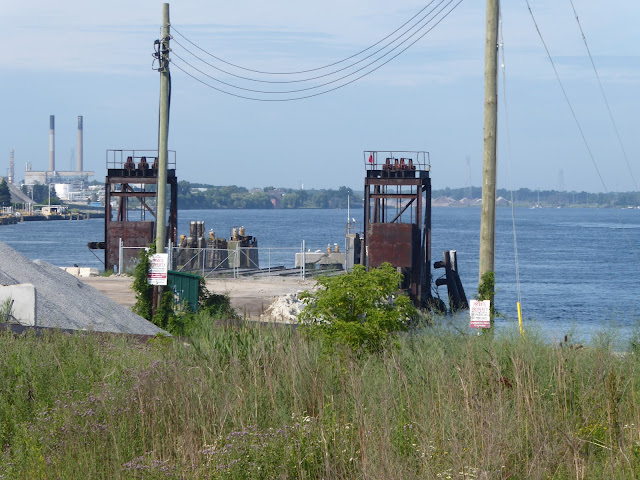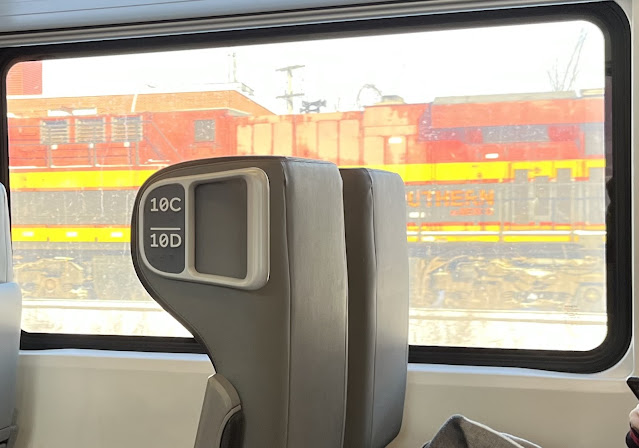This is part II of my Windsor history series. You can read the first entry by clicking here.
In August 2022, when I was taking photos of the interesting pieces of rolling stock at the Waterloo Central Railway's St. Jacobs yard, I spotted an RDC unit tucked away in the yard, far enough away from my vantage point on a nearby street that I couldn't get a clean photograph of it. But I got a reasonable shot. I give the volunteers running this operation credit. They painted the unit in the Canadian Pacific maroon and gold scheme, albeit lettered for the Waterloo Central. This maroon scheme predated the ubiquitous CP multimark scheme that was adopted in 1968. It got me to thinking.
In the late 1960s and early 1970s, it was clear that highways had supplanted passenger rail services as the dominant form of short-distance travel in much of Canada. Despite various attempts to modernize their service or innovate after the Second World War, both CP and CN were hemorrhaging money on their passenger services. In CN's case, it was a government owned corporation, which tended to soften the blow, but also force its hand to stick with its passenger services. CP was a different story, as it was not a government owned entity, although it was still subject to the same regulation that mandated passenger service standards at the time. So, in a sense, CP had the worst of all worlds.
That said, CP and CN were going in different directions as the 1970s approached. One was investing and another was actively bailing out.
At this time, my Dad had moved with his family to Windsor, Ont., as my grandfather was transferred from CP's facilities in Chapleau, in Northern Ontario, to the Windsor shops. In my Dad's case, this meant, as a teenager, he found himself with his first job at the CP yards in Windsor alongside my grandfather, who was a rolling stock mechanic.
My grandfather usually worked the RIP track, which is short for the repair-in-place track. He sometimes would work in the shed near the roundtable as well. There were times that he would be dispatched to wrecks around southern Ontario to ensure that the main line would be clear as quickly and safely as possible following an accident. In short, my grandfather did a little bit of everything. By contrast, my Italian grandfather (Nonno in Italian) was also living in Windsor at this time, but he had long since moved on from his work as a general track labourer with CP, which he did in the Crowsnest Pass district of B.C.
My Dad often worked nights at the CP yard alongside my grandpa. At the time, CP was still maintaining a national passenger network. A peak at the CP schedule from 1968 shows that there were two daily trains between Toronto and Windsor in both directions. This image below was taken from Steve Boyko's collection. Steve is the author of the traingeek.ca blog. He graciously allowed me to use this image for this post.
The timetable gives you clues as to CP's state of mind regarding regional passenger rail at the time. The four trips were all made with Dayliners, which is a fancy term for RDCs. The schedule shows two RDCs made morning runs, one from Toronto heading west at 8:30 a.m. and one from Windsor heading east at 7:15 a.m. The eastbound to Toronto arrived at 11:20 while the westbound to Windsor arrived at 12:40 p.m. That means a four-hour trip. A bit slow, but not bad considering the stops made en route.
The evening trains followed similar schedules. The evening train out of Toronto heading west left Union Station at 6:30 p.m. and arrived in Windsor at 10:40 p.m. The eastbound out of Windsor left at 5:05 p.m. and arrived in Toronto at 9:15 p.m.
So what are the clues that CP was not prioritizing the passenger service, other than the fact that the Budds were doing the hauling? Look closely at the left of the image and you see that the schedule advises that there are "Meal Stations" en route where food can be purchased at city prices. In other words, there appears to be no service on the train. It's also worth noting that CP has a bus service to Kitchener from its Galt passenger station, since Galt (part of Cambridge now) is quite a way from Kitchener and Waterloo.
The final clue as to what CP was thinking at the time can be found on the notation at the bottom of the schedule which lists Windsor's passenger terminal as "Tecumseh Road and Crawford Avenue." This is what my Windsor rail friend and blog contributor Kevin O'Neil said of the CP passenger terminal.
"CP’s Budd Cars stopped at Tecumseh W and Crawford. The whole intersection was realigned a few years ago so the two distinct wings of Tecumseh were connected with a sweeping curve, covering part of the Crawford right-of-way. The building that held the CP Express transfer docks is still there, although it hasn’t belonged to CP in the years of my conscious memory. It belonged to a private cartage company for many years, and now it’s a warehouse for a restaurant equipment supplier. I’ve never been able to pinpoint the location of the Budd waiting room."
So, in other words, CP had some sort of makeshift waiting room for passengers in a freight facility. Not uncommon in the days where railways were actively trying to discourage passenger travel. Now compare that image in your head to the Canadian Pacific's terminal near the Detroit River, which served from 1880 into the 1930s. I don't know that I have ever seen anything like this.
Image and the one that follows beneath are from the Southwestern Ontario Digital Archives at the University of Windsor and are used for informational purposes only, as per the disclaimer stated on the SWODA website.
After this station was demolished, CP moved its passenger operations into the Michigan Central station on Pelletier Street until it improvised a waiting room at the former corner of Tecumseh and Crawford in the 1960s. The MCR station was used by the New York Central's Canadian operations (legally the Canada Southern Railway, a subsidiary of MCR, which was owned by NYC) before its operations were merged into Penn Central and eventually Conrail. At this point, there were no passenger services offered by this successor railway, as Conrail's birth came after the establishment of Amtrak.
Sadly, this station is no longer around, as it was a victim of arson some years back. I do recall reading about this, but my thanks to Kevin for reminding me.
So back to my Dad. I do recall him telling me about his two most vivid memories of working in CP's yard during his early years. He told me he recalled walking alongside freight trains that had just arrived and filling the journal boxes with oil. This was, of course, at a time when there was still rolling stock around that used journals instead of roller bearings. Essentially, the axles were kept in running condition by fabric that was coated in oil. When these boxes containing this fabric and oil leaked and the oil spilled out, the axles would get hot. This is the origin of the term "hot box" I am told.
My Dad's other memory? He told me one of his jobs was to clean out the Budd cars that had arrived from Toronto. This is where his job got interesting. He often found that the cars were quite a mess when they arrived in the yard for servicing. He said it was quite common to find beer and liquor bottles on the cars, as well as a surprising amount of money. His suggestion was that there was usually an unsavoury element that rode these trains into Windsor at night.
Luckily for my Dad, Ontario Hydro offered him a better job with benefits and hours at the J. Clark Keith thermal generating station in Windsor (long since closed). His life on the railway and cleaning out the Budd cars was mercifully short.































.JPG)





.JPG)
















